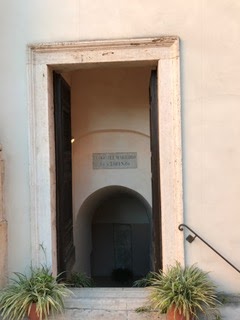Again today the homily was very thought provoking. The Church of St. Lawrence is built DIRECTLY over the spot where he was cooked alive (you can go down to the spot - see the photos below). The priest reminded us how Lawrence willingly and bravely went to the fire - where he was purified as a martyr for God. Lent is a time of purification for us. So, like St. Lawrence, we should willingly and bravely enter into the refining fires of Lenten discipline in order to be purified. Nice connection!
(from PNAC.org)
St. Lawrence, though considered a minor saint by many today, was once one of the most beloved saints both in Rome and throughout Latin Christendom, and rightly so. A deacon of the Roman Church in the mid-third century, he found himself faced with the task of administering the Church after the arrest of Pope Sixtus II and four of his fellow deacons in the Catacombs of Callixtus on 6 August 258. Meeting the pope while he was being led away to prison and execution, Lawrence begged to be able to accompany him. The pope turned this request down, giving the deacon charge of the temporal goods of the church, while telling him that the deacon would follow his bishop in four days time. Lawrence then went forth and gave away the material goods of the church to the poor in the city. Soon he in turn was arrested and brought before the magistrates, and when the treasures of the Church were demanded of him he presented to the authorities the poor, saying that these were the true treasures of the Church. The Romans, enraged by this seeming insolence, cast the deacon into a dark prison cell near the site of today’s church. There, he converted the jailer and his family. With the authorities only further angered by his success, they condemned him to be burnt alive over a gridiron set up on the site of today’s station. So it was that on 10 August 258, that St. Lawrence was burnt alive for his steadfast faith in Christ. As one final jab at his executioners, he is said to have remarked to them as his torments neared their end, “Turn me over, I’m done on this side.” And so he passed from the sufferings of this world to the glory of the next.
(from PNAC.org)
St. Lawrence, though considered a minor saint by many today, was once one of the most beloved saints both in Rome and throughout Latin Christendom, and rightly so. A deacon of the Roman Church in the mid-third century, he found himself faced with the task of administering the Church after the arrest of Pope Sixtus II and four of his fellow deacons in the Catacombs of Callixtus on 6 August 258. Meeting the pope while he was being led away to prison and execution, Lawrence begged to be able to accompany him. The pope turned this request down, giving the deacon charge of the temporal goods of the church, while telling him that the deacon would follow his bishop in four days time. Lawrence then went forth and gave away the material goods of the church to the poor in the city. Soon he in turn was arrested and brought before the magistrates, and when the treasures of the Church were demanded of him he presented to the authorities the poor, saying that these were the true treasures of the Church. The Romans, enraged by this seeming insolence, cast the deacon into a dark prison cell near the site of today’s church. There, he converted the jailer and his family. With the authorities only further angered by his success, they condemned him to be burnt alive over a gridiron set up on the site of today’s station. So it was that on 10 August 258, that St. Lawrence was burnt alive for his steadfast faith in Christ. As one final jab at his executioners, he is said to have remarked to them as his torments neared their end, “Turn me over, I’m done on this side.” And so he passed from the sufferings of this world to the glory of the next.
Today, the spot of his martyrdom is marked by this small church. A record of a church on this site, then called St. Lawrence in Formonso, exists from the late eighth century, and it seems that this church was built in the early seventh century. The current church was built to replace this in the period 1565-1574, being consecrated three years later. A restoration in 1757 gave the church the appearance it has today.
Beyond the high altar in this church is the 2nd largest wall fresco in the city of Rome - after the Sistine Chapel. It depicts Saint Lawrence on the gridiron, the flames already curling around him as the emperor sits in judgment in the background. Yet his eyes are turned upward toward heaven, where an angel is seen carrying down to him the crown of his victory, his reward for a battle fought through to victory. Through some side doors you can defend to the actual place of his martyrdom. Clean and well kept now, it takes your imagination to hear the crackle of the flames and the herring voices of the executioners, and the smell of the burning flesh of the saint. Yet perhaps more appropriately it is silent here, a brief forecast of the peace of Heaven that the brave deacon now enjoys.






No comments:
Post a Comment